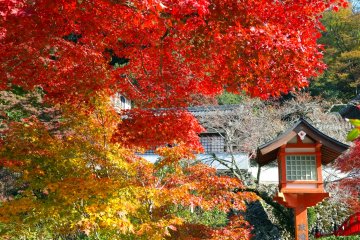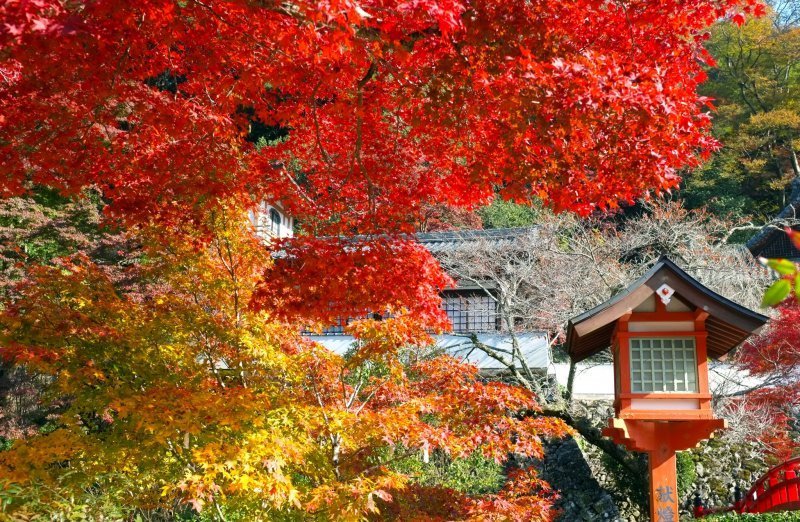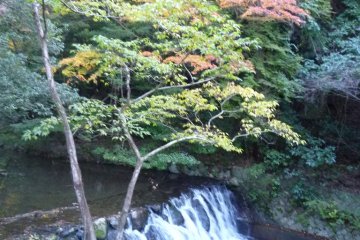
Выходные в парке Мино, Осака
Irma SyahriarНасладитесь осенними пейзажами и вкуснейшей момидзи темпурой в парке Мино на окраине Осаки.

Minoo Park, also referred to as Mino or Minoh, is a forested area on the outskirts of Osaka that provides residents and visitors alike a peaceful haven among nature. The scenic valley was given quasi-national park status in 1967 and is popular for its maple trees, well-maintained walking paths, quaint shops and restaurants, temples, and, most famously, for the stunning Minoo Waterfall.
Take a break from fast-paced city life and start a rejuvenating journey along Minoo Park’s most popular walking path. This three-kilometer trail begins near Hankyu Minoo Station and ends at Minoo Waterfall with a walking time of about 45 minutes to one hour (one way). The path’s well-paved roads and lack of major inclines make it a wonderful place for a relaxing stroll. For the first half of the trail, enjoy a flat walk among traditional homes, shops, restaurants, and enchanting forest scenery. While hiking, keep an eye out for wildlife, including monkeys and deer!
Ryuanji Temple marks the midpoint between the station and the waterfall and is a frequent stop for visitors. The seventh-century temple grounds are located to the right of a vibrant vermillion bridge and play host to scenic cherry blossoms in the spring and brilliant red foliage in autumn. Another notable destination along the trail is the Minoo Park Insect Pavillion, which features over 6,000 types of Japanese insects that are sure to satisfy your environmental curiosity.
The second half of the trail is more steep and isolated among the trees. At the end of your journey, you will reach your destination—Minoo Waterfall. This 33-meter tall waterfall is the park’s main attraction and has been used as a meditation site since the sixth century. Sit on one of the many benches near the falls, watch the rushing waters, and lose yourself to the calming sound of water.
The most popular time to visit Minoo Park is during autumn, specifically late November, when the park’s foliage changes color and the many maple trees turn bright red. During this seasonal celebration, the park’s shops sell tasty momiji tempura, which are maple leaves fried in batter. The unique snack is both sweet and salty with a crunchy exterior. Be sure to try the one-of-a-kind treat and pick some up as souvenirs.
For more secluded nature paths, explore hiking trails that extend off the main path into the surrounding hills. Maps are available at the beginning of the trail.
Take the Hankyu Takarazuka Line from Umeda Station to Ishibashi Station and then hop on the Hankyu Minoo Line to Minoo Station. From Minoo Station, the park is about a 10-minute walk.

Насладитесь осенними пейзажами и вкуснейшей момидзи темпурой в парке Мино на окраине Осаки.

Парк Миноо - это расслабляющие прогулки на природе, красивый водопад, музей насекомых и храмы.

Фестиваль огня, воды и света проходит с 12 июля по 31 августа, в это время работает ночная подсветка водопада.

С началом весны мы отправились на прогулку к водопадам Мино: красивые пейзажи и предприимчивые обезьяны гарантируются!

Katsuoji Temple, situated north of Osaka City and nestled in the idyllic nature of Minoo, is famous for its lucky reputation. For centuries, emperors and shoguns prayed at this temple for victory in their endeavors. Today, visitors still flock to the sacred grounds to pray for victor’s luck with work, academics, business, sports, and more. Katsuoji’s lucky atmosphere is complemented by an infinite amount of daruma dolls strewn across the complex, which are Japanese symbols of good luck. History The temple’s history began in 727 when two Buddhist priests, Zenchu and Zensan, constructed a hut to practice Buddhism. Later in 765, Prince Kaisei joined the priests as a student of Buddhism and built Mirokuji Temple onsite. About 15 years later, Myokan, who is said to be a reincarnation of Kannon Bosatsu, the goddess of mercy, added a sandalwood carved statue of Kannon with one thousand hands as a deity of the temple. However, the temple did not gain its lucky reputation until the ninth century when Emperor Seiwa fell ill. In an attempt to cure his illness, devout followers went to Mirokuji to pray for his recovery. After the emperor recovered, he attributed his renewed health to Mirokuji and renamed the temple Katsuoji, which roughly translates to, “the temple of the victorious king.” Katsuoji was initially written with the character for king, but was later changed to the similar sounding kanji for tail—creating a more modest temple name. Today - Daruma Traditions Today, Katsuoji still exudes an atmosphere of luck and is renowned for its ubiquitous daruma doll collection. These red dolls, large and small, are scattered throughout the complex, decorating seemingly every surface. Contribute your own luck to the temple by purchasing a daruma and participating in its ritual. After you purchase the doll, write your goal on the back and go to the main temple to light incense and pray for the success of your goal. After praying, paint a black circle in the doll’s right eye (both eyes are blank when purchased). Bring the incomplete doll home and place it in a spot you will see everyday to remind yourself of your goal. After you complete your goal, take the daruma back to Katsuoji, where they will color in the left eye in a meditative ritual. Congrats! Now you can place your doll on the temple grounds as a symbol of your victory. Alternatively, you can paint the left eye yourself and keep the doll in your home as a reminder of your success! Aside from the Katsuoji’s lucky aura, the temple grounds also create an inviting and tranquil haven among the trees. When you first approach the temple, you will be greeted by an impressive torii gate painted vermillion. After you pass under the entrance, you will cross over a lake on a mystical bridge that is shrouded in an ever-present mist. The main temple and surrounding structures are all painted vibrant red, matching the tiny scattered daruma. Enjoy the juxtaposition of Katsuoji’s brilliance against the natural tones of the surrounding mountains. The temple is especially beautiful when it is complemented by autumn leaves and springtime cherry blossoms.

Expo '70 Commemorative Park, located in Suita, Osaka, Japan, is a vast cultural and recreational area built on the site of the 1970 World Exposition. Spanning approximately 264 hectares, the park is a tribute to the historic event, which showcased technological advancements and cultural exchange from around the world. The park features a blend of natural beauty, with lush gardens, forests, and open lawns, alongside striking architectural and artistic installations. One of the park's most iconic landmarks is the "Tower of the Sun," a 70-meter-tall sculpture designed by the renowned artist Tarō Okamoto. This unique structure, symbolizing human evolution, remains a powerful reminder of the Expo's theme: "Progress and Harmony for Mankind." Visitors can explore various themed gardens, including the Japanese Garden, which offers serene landscapes, traditional tea houses, and seasonal floral displays. The park also hosts museums, such as the National Museum of Ethnology, and numerous recreational facilities, including sports fields, playgrounds, and walking trails. Expo '70 Commemorative Park is not only a significant historical site but also a vibrant space where culture, nature, and history intertwine, providing a peaceful retreat and a glimpse into Japan's modern heritage.

Находясь менее чем в тридцати минутах от центра Осаки, Выставочный парк Экспо, построенный на месте Всемирной выставки Японии 1970 года – это целых 260 гектаров в зоне тихого парка, безмятежных прудов и садов, наполненных яркими цветами и цветущими деревьями.